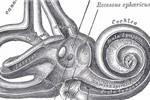Ebola’s immune escape
 WIKIMEDIA, NEPHRONAfter an Ebola patient has recovered from the infection and her blood is virus-free, Ebola can still linger, hiding out—and sometimes replicating— for months in the immunoprivileged tissues of the body, including the eye, the placenta, and the brain.
WIKIMEDIA, NEPHRONAfter an Ebola patient has recovered from the infection and her blood is virus-free, Ebola can still linger, hiding out—and sometimes replicating— for months in the immunoprivileged tissues of the body, including the eye, the placenta, and the brain.
“The only possible way that we could surmise that the virus could be present is that it was seeded from the acute original infection and persisted,” Daniel Bausch, who researches emerging pathogens at Tulane University in New Orleans and who worked with the World Health Organization (WHO) during the West African Ebola epidemic, told The Scientist. “We have very ample and increasing evidence that the virus can persist in some of these sites.”
Now researchers are trying to understand how Ebola survives in these tissues—and how to knock out the virus for good, though Bausch emphasizes that the evidence suggests Ebola will eventually disappear on...
Gut microbiome and immunotherapy
 WIKIMEDIA, NIHThe composition of a mouse’s gut microbiome can influence the effectiveness of cancer immunotherapy, according to two studies from independent research teams published this week (November 5) in Science Express.
WIKIMEDIA, NIHThe composition of a mouse’s gut microbiome can influence the effectiveness of cancer immunotherapy, according to two studies from independent research teams published this week (November 5) in Science Express.
Researchers in France found that germ-free mice with sarcomas, melanoma, or colorectal tumors did not respond to an immunotherapy antibody against CTLA-4, but adding Bacteroides species or memory T cells targeting those gut microbes restored the immunotherapy’s anti-tumor effect. Meanwhile, a group based at the University of Chicago found that laboratory mice of the same strain that had been bred at two different facilities and were known to harbor different commensal bacteria responded differently to another immunotherapy, against PD-L1, after being implanted with melanoma tumors. But fecal transplants from the more responsive set of mice to the less responsive group improved their ability to fight their cancer. Sequencing the gut microbiome of the mice, the researchers identified Bifidobacterium species as key to the anti-tumor immune response.
“These interesting papers combine two of the hottest areas in science—the microbiome and immunology—showing that gut bacteria can activate [host] anti-tumor responses,” said Timothy Hand of the department of immunology at the University of Pittsburgh who was not involved in either study.
How PJVK mutations lead to hearing loss
 WIKIMEDIA, HENRY GRAYThe protein pejvakin, encoded by the PJVK gene, is necessary to protect inner ear cells from oxidative stress following exposure to loud noises, according to a study published this week (November 4) in Cell. People with PJVK mutations have diverse symptoms of hearing loss, from slight impairments to profound deafness, leading to confusion about what might be causing the problem.
WIKIMEDIA, HENRY GRAYThe protein pejvakin, encoded by the PJVK gene, is necessary to protect inner ear cells from oxidative stress following exposure to loud noises, according to a study published this week (November 4) in Cell. People with PJVK mutations have diverse symptoms of hearing loss, from slight impairments to profound deafness, leading to confusion about what might be causing the problem.
Studying mice that lack pejvakin, Christine Petit of the Institut Pasteur and the Collège de France and her colleagues found that the animals’ inner ear hair cells and auditory neurons were hypersensitive to sound, suffering damage much more quickly than control mice. The problem seemed to stem from an inability to increase pejvakin levels and the number of peroxisomes, enzyme-filled organelles involved in reducing oxidative stress.
“I think that that link between a single gene mutation in humans and the mouse model leading through to noise-induced damage . . . is really interesting,” Karen Steel, a geneticist at King’s College London who did not participate in the study, told The Scientist. “People don’t tend to think about, ‘Well, what can a single gene mutation tell you about a common environmental problem like noise-induced damage?’ But this actually makes that link in one paper, which I think is really impressive.”
Weaponizing milkweed
 FLICKR, USFWS MIDWESTMonarch and queen butterfly caterpillars evolved the ability to store toxins from the milkweed they eat in order to ward off birds and other predators, not simply to allow them to eat the noxious plant, according to a study published Wednesday (November 4) in Proceedings of the Royal Society B.
FLICKR, USFWS MIDWESTMonarch and queen butterfly caterpillars evolved the ability to store toxins from the milkweed they eat in order to ward off birds and other predators, not simply to allow them to eat the noxious plant, according to a study published Wednesday (November 4) in Proceedings of the Royal Society B.
“I would call it a landmark paper,” said Michael Singer, a professor at Wesleyan University who studies similar systems but was not involved in this study. “[It helped] distinguish between these alternative views” of how and why insects develop resistance to toxins.
More news in life science:
Fingerprints Yield Sex Info
The amino acids left behind in a human fingerprint can be used to determine whether an individual is male or female.
Understanding Global Migration
World Science Forum panelists discuss how scientists can better decipher the factors that drive global migration in order to affect policy change.
A Literature Database with Smarts
Semantic Scholar uses machine reading and vision to extract meaning and impact from academic papers.
Allele Linked to Obesity in People
A single nucleotide polymorphism in BDNF is tied with lower levels of the protein and higher body-mass index.
A Tiny Missing Link?
The common ancestor of all apes, including great apes and humans, may have been not-so-great in stature.
Interested in reading more?





